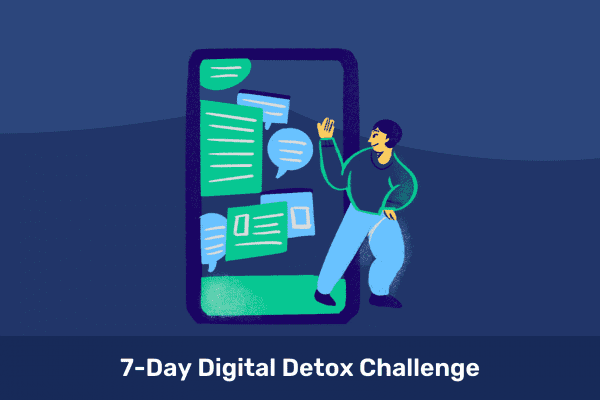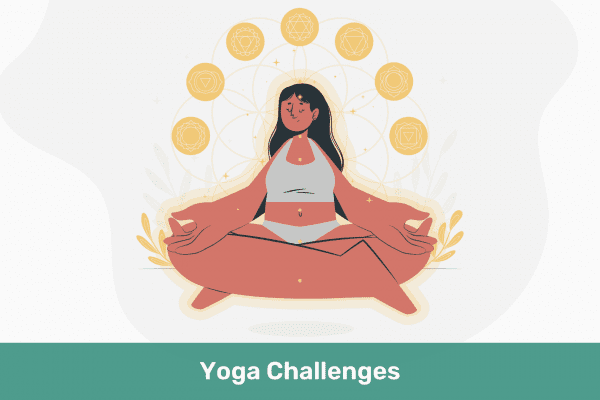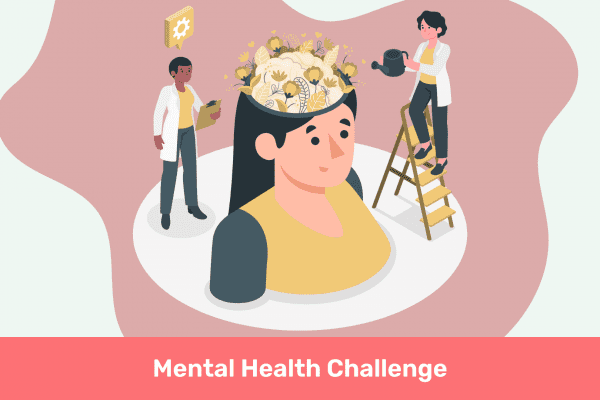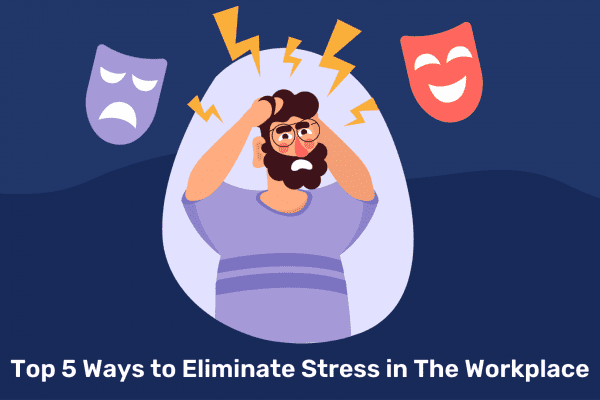Introduction
Workdays can be tough – full of deadlines, meetings, and unexpected challenges. But what if you could find a way to stay calm and focused amidst it all? Our ‘7 Days of Meditation at Work’ is designed to help you do just that. We’re going to explore simple meditation techniques that you can easily fit into your workday routine. These practices are all about giving you tools to handle stress better, sharpen your focus, and enhance your overall work experience. So, let’s get started and see how a few mindful moments each day can make a big difference in your work life.
Day 1: Breathing Meditation at Work for Focus and Calm
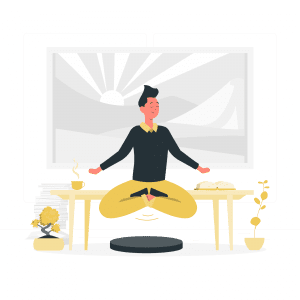
Welcome to the first day of our meditation at work series. Today, we’re focusing on Breathing Meditation – a fundamental yet incredibly effective technique to bring about focus and calm in the workplace.
Breathing Meditation at Work: The Basics
This meditation centers on focusing on your breath as a means to ground your thoughts. It’s particularly useful for those hectic moments at work when you need a quick way to regain composure.
How to Practice:
-
-
- Find a Quiet Corner: Choose a peaceful spot at work, like a rarely used meeting room, or simply stay at your desk.
- Conscious Breathing: Sit comfortably and turn your attention to your breath. Notice the sensation of air flowing in and out of your nostrils or the movement of your chest and belly.
- Return When Distracted: It’s natural for your mind to wander. Each time it does, gently redirect your attention back to your breath.
- Regular Short Sessions: Start with short, five-minute sessions. This can be a brief pause between tasks or during your break.
-
Why It’s Effective for Work:
Breathing meditation at work helps to quickly reduce stress levels and improve concentration. It’s a tool you can use throughout the day, not just for lowering anxiety but also for enhancing clarity and productivity.
Incorporating It into Your Workday:
Try to integrate this practice into your daily routine. Before starting a challenging task, take a few minutes to meditate. It can also be a great way to decompress after a meeting or to prepare for a presentation.
Day 1 is about discovering how simple breathing meditation at work can be a game-changer for managing your workday stress and maintaining mental clarity. Remember, just a few minutes can reset your entire mindset, making you ready to tackle the next challenge with a calmer, more focused approach.
Day 2: Mindful Breaks – Integrating Short Meditation at Work

On the second day of our series, let’s explore how taking mindful breaks with short meditation sessions can significantly enhance your workday. This practice is about using brief pauses to refresh your mind and rejuvenate your focus.
Mindful Breaks at Work:
Mindful breaks involve stepping away from your work tasks for a few moments to engage in a brief meditation. It’s a chance to clear your head and reset your energy.
How to Practice:
-
-
- Schedule Your Breaks: Plan two to three mindful breaks throughout your workday. They can be as short as three to five minutes each.
- Find Your Space: Whether it’s a quiet corner, a park bench outside, or even at your desk, find a spot where you can pause undisturbed.
- Engage in Mindfulness: Close your eyes and bring your attention to the present moment. Acknowledge your thoughts and surroundings, then gently let them pass without judgment.
- Deep, Focused Breathing: Incorporate deep breathing to deepen your sense of relaxation. Focus on each inhale and exhale to enhance your mindfulness.
-
Why Mindful Breaks Work:
These short meditation sessions at work are perfect for combating mental fatigue. They provide a mental reset, reducing feelings of being overwhelmed and helping you return to your tasks with renewed focus and energy.
Incorporating Them into Your Work Routine:
-
-
- After completing a task, take a mindful break before starting the next one.
- Use these breaks as a tool to prepare for or wind down from meetings.
- Encourage your team to join in, fostering a more mindful and productive work environment.
-
On Day 2, we recognize that meditation at work doesn’t need to be time-consuming. Even the shortest breaks, when done mindfully, can have a profound impact on your mental well-being and work performance. So, give yourself the gift of these moments and notice how they bring about a positive change in your workday rhythm.
Day 3: Desk-Based Meditation at Work for Stress Relief

Day 3 of our meditation at work series is about integrating desk-based meditation techniques to alleviate stress and enhance mental clarity right from your workstation.
Desk-Based Meditation: An Oasis at Work:
Desk-based meditation is a convenient way to incorporate mindfulness into your busy schedule, without needing to leave your workspace. It’s particularly effective for those moments when stepping away from your desk isn’t an option, but you still need a mental breather.
Practicing Desk-Based Meditation:
-
-
- Seated Comfortably: Sit in your chair with your feet flat on the floor, hands resting on your lap, and spine straight yet relaxed.
- Focused Attention: Gently close your eyes or soften your gaze. Turn your attention inward, focusing on your breath or a specific object like a plant or a photo on your desk.
- Mindful of Your Environment: Acknowledge the sounds and activities around you. Allow them to be part of your meditation, observing them without judgment.
- Use Short Phrases: Silently repeat a calming word or phrase with each inhale and exhale, helping to maintain focus and presence.
-
Benefits in the Workplace:
Engaging in this form of meditation at work, even for just a few minutes, can significantly reduce stress. It helps in distancing yourself from work pressures and regaining a sense of control and calm.
Incorporating It Throughout Your Day:
-
-
- Consider starting your day with a brief desk-based meditation to set a positive tone.
- Use this technique as a tool to refocus during periods of high stress or after long meetings.
- End your workday with a short session to help transition from work mode to personal time.
-
Day 3 is all about discovering the ease and effectiveness of desk-based meditation at work. It’s a tool that’s always accessible, offering quick relief from stress and a way to recenter yourself amidst a hectic workday. Give it a try and observe how it transforms your approach to daily workplace challenges.
Also Read: Innovative Desk Workout Equipment for Office Fitness
Day 4: Body Scan Meditation for Tension Release at Work

Welcome to Day 4 of our ‘Meditation at Work’ series. Today, we focus on the Body Scan Meditation, a technique designed to reduce tension and promote relaxation, which can be especially beneficial in a work setting.
Understanding Body Scan Meditation:
Body Scan Meditation involves mentally scanning your body for areas of tension and consciously releasing it. This practice helps in identifying where you hold stress in your body, often leading to greater mind-body awareness and relaxation.
How to Practice a Body Scan at Work:
-
-
- Find a Quiet Space: Use a quiet room or stay at your desk. You can do this sitting or if possible, lying down.
- Start from the Top (or Bottom): Close your eyes and start focusing on your head, gradually moving down to your toes or vice versa. Pay attention to each part of your body.
- Notice and Release: As you mentally scan each area, notice any tension or discomfort. Imagine breathing into that area, and as you exhale, let the tension release and dissipate.
- Be Gentle and Patient: If your mind wanders or if you find areas that are particularly tense, acknowledge this gently, without judgment, and continue your scan.
-
Benefits of Body Scan Meditation at Work:
-
-
- Stress and Tension Relief: This practice can help to release physical discomfort caused by stress, such as neck stiffness or headaches.
- Increased Awareness: Regularly performing a body scan can increase your awareness of how stress impacts your body, allowing for earlier intervention.
- Improved Focus and Productivity: By reducing tension, you’re more likely to return to your tasks with improved concentration and efficiency.
-
Incorporating Body Scan into Your Workday:
-
-
- Consider beginning your day with a body scan to start with a relaxed mindset.
- Use it as a midday break to reset and release any accumulated tension.
- End your day with this practice to let go of the day’s stress, separating work from personal time.
-
Day 4 of our series shows how a simple body scan meditation at work can be a powerful tool for managing stress. It’s a way to check in with yourself, care for your well-being, and maintain a sense of calm throughout your workday.
Day 5: Loving-Kindness Meditation to Enhance Work Relationships
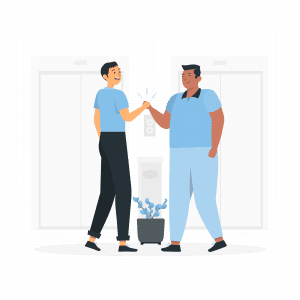
Day 5 of our ‘Meditation at Work’ series introduces you to Loving-Kindness Meditation, a practice that not only soothes your mind but can also positively impact your interactions and relationships at work.
Loving-Kindness Meditation at Work:
Loving-Kindness Meditation focuses on developing feelings of goodwill, kindness, and warmth towards others and yourself. In the context of work, it can be a valuable tool for promoting a positive workplace atmosphere and improving interpersonal relations.
Practicing Loving-Kindness Meditation:
-
-
- Find a Quiet Spot: Take a few minutes during a break or before starting your workday to practice this meditation.
- Start with Yourself: Begin by silently repeating phrases of goodwill towards yourself, such as “May I be happy, may I be healthy, may I be at peace.”
- Extend to Others: Gradually extend these wishes to your colleagues, imagining sending them thoughts of kindness and well-being. “May you be happy, may you be healthy, may you be at peace.”
- Widen the Circle: You can then extend these thoughts to more challenging relationships at work, and eventually, to all beings universally.
-
Benefits in a Professional Setting:
-
-
- Reduced Workplace Tension: Regular practice can ease interpersonal tensions and conflicts.
- Enhanced Empathy: Helps in understanding and empathizing with colleagues’ perspectives.
- Boosted Team Morale: Contributes to a more supportive and positive work environment.
-
Integrating Loving-Kindness at Work:
-
-
- Practice this meditation in moments of frustration or anger.
- Use it to start meetings on a positive note, focusing on team cohesion and mutual respect.
- Encourage a culture where positive intentions are set towards each other’s well-being and success.
-
On Day 5, we explore how bringing an attitude of loving-kindness into your work life can transform not just your own state of mind but also influence your work environment positively. It’s about cultivating a spirit of generosity and kindness that extends beyond meditation into every interaction.
Day 6: Concentration Meditation to Enhance Focus at Work
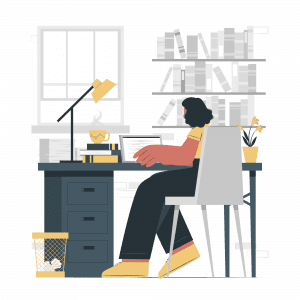
Welcome to Day 6 of our ‘Meditation at Work’ series. Today, we delve into Concentration Meditation, a practice particularly beneficial for enhancing focus and attention, which can be incredibly valuable in any work setting.
Concentration Meditation at Work:
Concentration Meditation involves focusing your attention on a single point. This could be your breath, a specific word, or even a visual object. The practice is about bringing your mind back to this focal point whenever it wanders, thereby enhancing your ability to concentrate.
How to Practice:
-
-
- Choose Your Focus: Select a point of focus. It could be the sensation of breathing, a word or ‘mantra’ you repeat silently, or a visual object like a flower or a picture.
- Find a Quiet Space: Ideally, find a spot where you won’t be disturbed. If that’s not possible, simply reduce distractions as best as you can.
- Set a Time Limit: Start with short sessions, about five minutes, and gradually increase as you become more comfortable with the practice.
- Gently Refocus: Your mind will wander. That’s normal. The practice is about gently bringing your attention back to your chosen focal point without judgment.
-
Benefits for Work:
-
-
- Improved Concentration: Regular practice can increase your ability to focus on work tasks, leading to higher productivity.
- Reduced Mental Clutter: Helps in clearing your mind of unnecessary thoughts, making it easier to prioritize and manage tasks.
- Enhanced Mental Stamina: Like a muscle, your ability to concentrate can be strengthened over time with consistent practice.
-
Incorporating It into Your Workday:
-
-
- Practice concentration meditation during your scheduled breaks as a mental reset.
- If you find yourself losing focus while working, take a couple of minutes to engage in this practice.
- Use it as a tool to prepare for tasks that require high levels of concentration and focus.
-
Day 6 in our series is about harnessing the power of concentration through meditation. By training your mind to focus, you’re equipping yourself with a skill that not only enhances your work performance but also contributes to a more fulfilling work experience.
Day 7: Reflective Meditation to End the Workweek
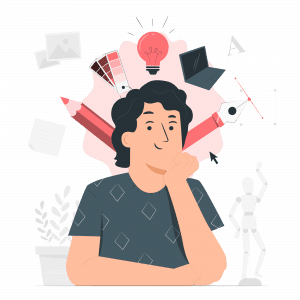
On the final day of our ‘Meditation at Work’ series, let’s explore Reflective Meditation. This practice is about looking back over your week, recognizing achievements, and contemplating areas for growth, which can be incredibly beneficial in closing your workweek with mindfulness and intention.
Reflective Meditation at Work:
Reflective Meditation involves taking time to ponder and analyze your thoughts, feelings, and experiences. At work, this can help in assessing challenges, successes, and learning points from the week.
How to Practice:
-
-
- Find a Quiet Space: At the end of your workweek, find a few minutes of uninterrupted time.
- Relax and Reflect: Sit comfortably, close your eyes, and take a few deep breaths to relax. Begin to reflect on the past week – the high points, the challenges, and everything in between.
- Ask Guiding Questions: Pose questions to yourself like, “What did I learn this week?” “What am I proud of?” “What could I do differently?”
- Acknowledge and Accept: Recognize your accomplishments and also acknowledge areas where you faced difficulties. Accept these experiences without judgment.
-
Benefits for Work:
-
-
- Enhanced Self-Awareness: Helps in understanding your reaction to work situations, leading to better emotional intelligence.
- Celebration of Achievements: Acknowledging what you’ve accomplished can boost confidence and motivation.
- Identifying Areas for Growth: Reflecting on challenges can provide insights for professional development and improvement.
-
Integrating It into Your Work Routine:
-
-
- Make reflective meditation a regular end-of-week practice.
- Use insights from this meditation to plan for the coming week, setting intentions and goals.
- Encourage a team reflection session, if appropriate, to share learnings and foster a supportive work culture.
-
On Day 7, Reflective Meditation brings closure to our week-long journey. It offers a chance to pause, review, and reset. As you adopt this practice regularly, you may find it becomes a powerful tool for personal and professional growth, allowing you to approach each new week with clarity, purpose, and mindfulness.
Conclusion
As we wrap up our ‘7 Days of Meditation at Work’ series, it’s important to reflect on the transformative power these practices can bring to your professional life. Over the past week, we’ve explored a variety of meditation techniques, each with its unique benefits, from reducing stress and enhancing focus to fostering better work relationships and self-awareness.
Studies, like those published by the NIH, support these experiences, indicating that mindfulness meditation positively influences mental and physical health, improving overall job performance, satisfaction, and engagement. This highlights the profound impact that just a few minutes of meditation can have on our workdays.
As you continue to explore and integrate these practices into your daily routine, remember that the journey towards a mindful work life is ongoing. It’s about making small, consistent changes that collectively contribute to a more fulfilling and productive work experience.
This is where Woliba comes in, acting as your partner in fostering a culture of wellness and mindfulness in the workplace. Our platform is designed to support these meditation practices, making it easy for you and your team to track and maintain your mindfulness journey. With Woliba, you can transform the way you work, ensuring that mindfulness and productivity go hand in hand. Let Woliba be the catalyst in your journey towards a more mindful, balanced, and effective work life, helping you to harness the full benefits of meditation every day. Contact us today!

